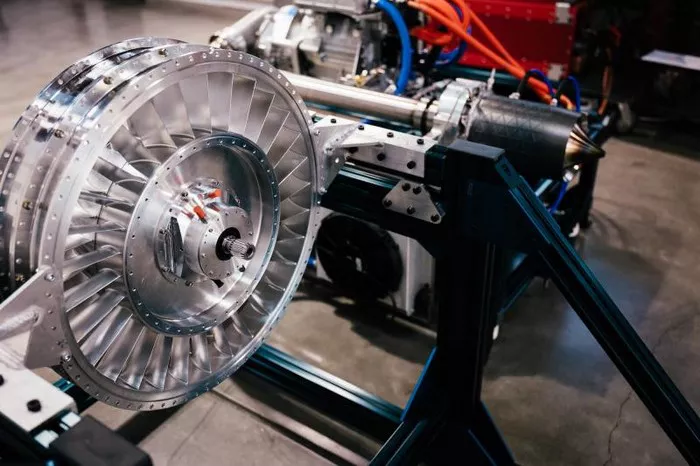Astro Mechanica, an aerospace startup founded in 2021 by Ian Brooke, is positioning itself at the forefront of aviation innovation with its development of a turboelectric adaptive engine. The company, staffed by a small team of just eight employees, is working to revolutionize both subsonic and supersonic aircraft operations with a groundbreaking approach to engine technology.
Innovative Engine Design Combines Electric and Jet Power
The heart of Astro Mechanica’s ambitious plans lies in its turboelectric adaptive engine, a hybrid system that blends electric motor technology, commonly seen in electric vehicles, with traditional aviation power systems. The engine is designed to function as both a turbojet and a turbofan within a single unit, offering the potential for greater efficiency and versatility.
The engine’s architecture consists of two primary components: a turbogenerator that powers an electric motor, which, in turn, drives additional electric motors. These motors independently control the compressor and turbofan, allowing for adaptive air compression based on operational conditions. This novel design enables more efficient combustion and dynamic performance across a range of flight speeds.
A New Approach to Engine Efficiency
The innovation behind the turboelectric adaptive engine lies in its separation of the fan and compressor functions, a departure from traditional designs. By using high-performance electric motors to drive the compressor—similar to those in modern electric cars—Astro Mechanica’s engine addresses the efficiency limitations seen in conventional aircraft engines. The independent control of the compressor ensures better combustion efficiency and allows for optimized performance at both subsonic and supersonic speeds.
Key Milestone: Successful Hot-Fire Test
Astro Mechanica achieved a major milestone on October 11, 2024, when it successfully completed a hot-fire test of its Gen3 turboelectric engine. The test, conducted at 30% power, demonstrated the engine’s ability to function under realistic operational conditions. This success marks an important step in proving the viability of the turboelectric adaptive engine for future commercial and military aircraft.
Challenges of Traditional Turbojets
Traditional turbojets, commonly used in military fighter jets, face significant challenges at lower speeds. In these engines, exhaust gases spin a turbine, which draws in air for combustion. While this system is highly efficient at supersonic speeds, it becomes inefficient at slower speeds, as the engine struggles to compress enough air for effective combustion, wasting fuel during takeoff and landing.
A prime example of this issue was the Concorde, the supersonic airliner that operated from 1976 to 2003. The Concorde’s turbojets were notoriously inefficient at low speeds, consuming around 2 tons (627 gallons or 2,372 liters) of fuel just to taxi from the gate to the runway.
Turbofan Engines and Their Limitations
Turbofan engines, which are more efficient than turbojets at lower speeds, also have their trade-offs. These engines generate thrust by moving large volumes of air through the engine, which works well at subsonic speeds. However, at higher speeds, the large fan blades produce considerable aerodynamic drag, reducing the engine’s overall efficiency and performance.
Astro Mechanica’s Multi-Mode Engine Design
Astro Mechanica’s turboelectric adaptive engine operates in three distinct modes, offering flexibility across a range of flight conditions. In Mode 1, the electric motor drives the “blisk” (bladed disk), which functions as both the compressor and turbofan. This mode operates without combustion and is ideal for subsonic flight and ground operations.
Mode 2 introduces combustion, with the electric motor continuing to drive the compressor to ensure efficient air compression. This allows the engine to achieve supersonic speeds without relying on exhaust gases, unlike traditional turbojets.
Finally, in Mode 3, the engine adopts a ramjet-like configuration. Using the Ram Pressure effect, the engine compresses air at high speeds, enabling the potential for speeds up to Mach 3 or faster, all while using no moving parts.
A Glimpse Into the Future of Aviation
With its groundbreaking technology and recent successes, Astro Mechanica is poised to make significant strides in the future of flight. The company’s turboelectric adaptive engine promises a leap forward in both efficiency and range, potentially offering 61% more range than the historic Concorde, and paving the way for more sustainable and cost-effective aviation technologies.
Related topics:

